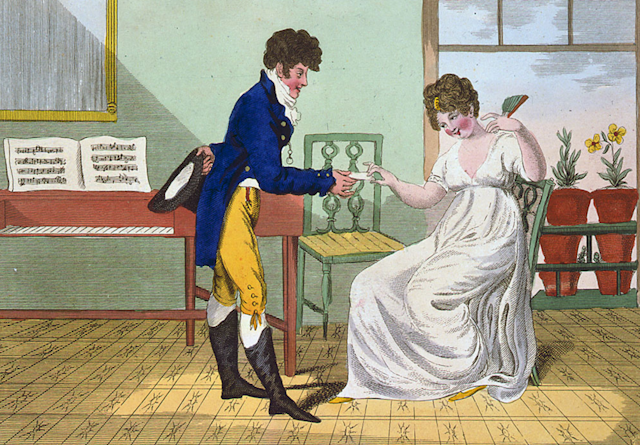If there was one thing the Georgians loved, it was the idea of love itself. The Georgian era, from the coronation of George I in 1714 to the death of George IV in 1830, saw a celebration of love and marriage in popular culture, including in bestselling novels such as Samuel Richardson’s Pamela, or Virtue Rewarded (1740), which reaches its climax with the marriage of the heroine to her master, Mr B.
You can listen to more articles from The Conversation, narrated by Noa, here.
Making a socially advantageous match that was also based on love and affection was the highest-stakes game men and women would ever play. How they experienced this emotionally fraught process is the subject of my book: The Game of Love in Georgian England.
In an age of rapid change in how we form our own attachments, it might be nice to shake things up and look to the past for some tips. Here are five dating trends from the Georgians that might shape up the process of looking for love.

This article is part of Quarter Life, a series about issues affecting those of us in our twenties and thirties. From the challenges of beginning a career and taking care of our mental health, to the excitement of starting a family, adopting a pet or just making friends as an adult. The articles in this series explore the questions and bring answers as we navigate this turbulent period of life.
You may be interested in:
Online dating fatigue – why some people are turning to face-to-face apps first
Sally Rooney’s Conversations with Friends – how we’ve become tougher on adultery
Love Island – what the show can teach young people about commitment
1. Go analogue
The Georgian era was the great age of letter writing, with courting couples exchanging a veritable torrent of romantic missives. Some found that the practice of writing helped them to express sentiments that they wouldn’t dare verbalise in person. As treasured sources of intimacy, introspection and self-revelation, a flurry of love letters could even surpass the number of in-person meetings.
Letters were treated as precious vessels for love to be touched, kissed, spritzed with perfume and used to inspire romantic verse. They were often carried around in a person’s pockets, and hidden beneath their pillow to inspire dreams while they slept at night.
Many kept their love letters to reread over and over again, storing them away as precious evidence of a relationship and a momentous time in their lives. (And, if it came to it, important physical evidence of commitment in court.)
2. Share a good book
The period saw a boom in the number of printed titles, with the novel emerging as a new genre and ever-increasing numbers of men and women able to read and write. As a result, books became popular romantic gifts.
Some women used books to try and get a man to express his feelings more readily. The feminist philosopher Mary Wollstonecraft sent a volume of Jean-Jacques Rousseau’s best-selling novel Julie, or The New Heloise (1761) to her lover William Godwin in 1796, with the request that he “dwell on your own feelings – that is to say, give me a bird’s-eye view of your heart”.
The shrewdest lovers marked up their books by highlighting the passages that they most agreed with, thereby ensuring that they found a spouse with a similar intellect, interests and outlook on life.
3. Get crafting

Georgian women invested hours making delicately crafted gifts for their suitors. A woman might make her lover a handkerchief, waistcoat, watch chain, watch paper and ruffles as tokens of her affection. The act both demonstrated her virtue and accomplishment as a needlewoman, while showing her investment in a relationship through the time and labour that she dedicated to it. It also enabled her to lay claim to a man when he wore her creations in public.
4. Say it with hair
What could be so personal as literally giving someone part of your body as a gift?
Hair had special meaning as a token as – like everlasting love – it did not fade or decay over time. To give a man a lock of your hair was a sure sign that you would soon be wed. As Margaret Dashwood presumed in Jane Austen’s Sense and Sensibility (1811), Willoughby and Marianne were certain to “be married very soon, for he has got a lock of her hair”. The Georgians set locks of hair into an assortment of jewellery including buttons, brooches, lockets, bracelets, and rings, which were plaited, studded with tiny seed pearls, and even chopped up to make delicate hair-work paintings.

It wasn’t always hair from your head either. The aristocrat Lady Caroline Lamb sent an envelope of pubic hair to her lover Lord Byron during their torrid affair in 1812, and the Yorkshire heiress Anne Lister stored pubic hair collected from her female lovers in a cabinet, which she kept as “curiosities”.
5. Bundle up
Poorer rural couples engaged in a tradition known as “bundling” which was practised throughout Wales, Ireland, and Scotland. It involved a couple getting into bed together in the woman’s family home – fully-dressed – sometimes separated by a plank of wood, or with the woman’s petticoat tied at the bottom with a knot. The ritual helped couples to bond by spending time alone and staying up late talking, without necessarily committing to sex.
And yet plenty of young couples did that too – illegitimacy rates rose steeply over the century, and up to one-third of brides in England were already pregnant on their wedding day.

These various words, tokens and acts of love provided a vital means for men and women to get to know each other, test their compatibility, and build a greater intimacy before marriage. The ultimate goal was a happy and contented union with a partner of similar rank and fortune. It provided a crucial pathway to that other key goal of the era – and indeed for many relationships today – lasting happiness.

